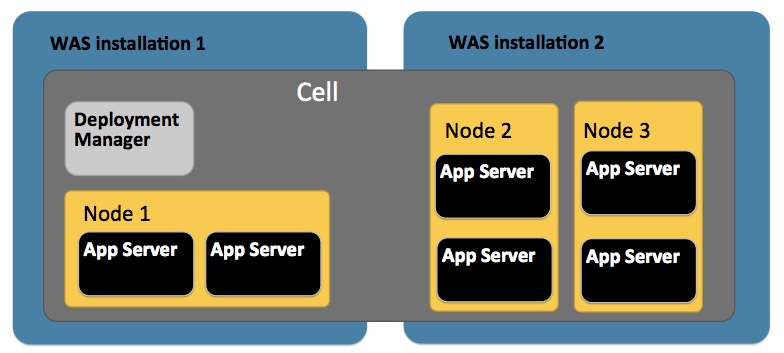If you are not familiar with the basic concepts upon which WebSphere operates, then read on...
There are many components in a WebSphere environment and it's not difficult to get confused about how they relate to each other. Our Solution uses the basic concepts of Cell, Node, and Server to serve up the WebSphere data and open the window to where the data lies hidden.
We will quickly review some of the basic concepts of cell, node, server, and so on.
- An Application Server in this context is a single WebSphere application server,
- A server is a runtime environment. Servers are Java process responsible for serving J2EE requests (for example, serving JSP pages, serving EJB calls, consuming JMS queues, and so on).
- The Admin Console is a browser based application that is pre-installed in your WebSphere environment that enables you to manage your application servers and applications.
- A cell is a grouping of nodes into a sigle administrative domain. For WebSphere this means that if you group several servers within a cell, then you can use one admin console to administer them.
- Network Deployment Manager is an application server running an instance of the Admin console. You have administrative control over all other app servers in the same cell.The Deployment Manager is a process (a special WebSphere instance) responsible for managing the installation and maintenance of Applications and other resources related to a J2EE environment. It also maintainins user repositories for authentication and authorization for WebSphere and other applications running in the environment. The Deployment Manager communicates with the Nodes through another special WebSphere process, the Node Agent.
- A node is a grouping of servers that share common configuration on a physical machine. It is comprised of a Node Agent and one or more Server instances. Multiple WebSphere nodes can be configured on the same physical computer system.
- The Node Agent is the administrative process responsible for spawning and killing server processes and also is responsible for synchronizing configuration between the Deployment Manager and the Node. Note that multiple WebSphere nodes can be configured on the same physical computer system. A single Node Agent supports all application servers running on the same node.
- Clusters are virtual units that group Servers. They can contain multiple instances of the same application server and can span multiple nodes. Resources added to the Cluster are propagated to every Server that makes up the cluster, This usually affects the nodes in the server grouping.

No comments:
Post a Comment